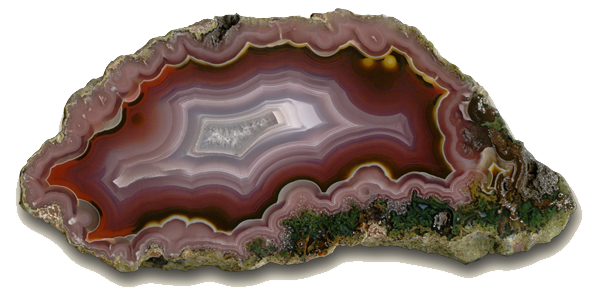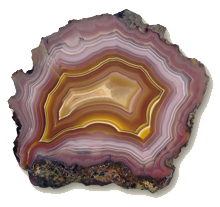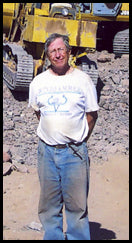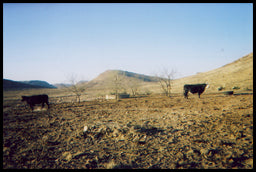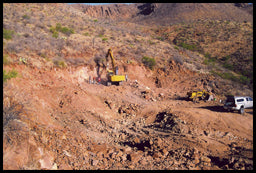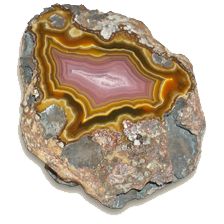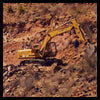Agua Nueva Mining Operation 2008
In 2008, I had no definite plans to mine in Mexico as I have for the past several years. I was ready to work at Laguna on the Alianza claim but could not confirm the rental of an excavator. Armondo had asked me to come and remove overburden so they could continue to work by hand.
I had been talking with Hector Corillo Jr. for several years about helping me with a mining operation in Mexico and was very surprised when he called me in March. The nodular deposit on the Agua Nueva Ranch has very hard rock, and I had expressed to Hector that it could only be mined effectively with explosives or a machine with an hydraulic ram. Hector informed me that he had a friend who had such a machine, and that it was in for repairs. After the repairs were complete, his friend would be willing to rent it to us for a month before he needed the machine elsewhere. I had about 10 days to decide.
The rental of an excavator with a Hydraulic ram is about twice the cost of an excavator alone. I thought this would still be worth it give the potential of the deposit. Hector and I made a deal where I was responsible for all the mining expenses, and he would manage the operation after I got it started and provide the use of this front end loader. We would split the production 75/25 with the option that I could buy is 25% at fair market value. I left for Mexico on March 18th.
Gary McFarlane agreed to accompany me on this mining adventure. We crossed the border on Saturday and drove to Estacion Ojo Laguna. We stayed with Armondo and his family for Easter and then drove to the Agua Nueva Ranch on Monday. I was concerned about the condition of the road to the mine and wanted to inspect it before Hector arrived in a few days. Much to my surprise the road was in perfect condition all the way to the last water tank. The Agua Nueva Ranch is primarily a cattle ranch. There are water tanks strategically placed on the ranch for the cattle. These are connected by dirt roads or trails. The route of one of these roads was followed about ¾ of the way to the mine.
On Tuesday we moved the trailer to the water tank near the mine and started to fix the road to our camping area with a pick and shovel. That afternoon Hector arrived with the front-end loader, and we finished repairing the road to the camp. Gary and I moved my trailer to the camp area and started setting up camp while Carlos (Hector's employee) worked on the road from the camp to the mine. Later that day Hector arrived with the excavator and a trailer to live in. The rental of the excavator came with an operator for the ram. Since the operator could not be there until the following Monday, we took the ram off the machine and put on the bucket. This process took about an hour and required removing and replacing four large pins. Carlos and I spent the next three days cleaning the mine of overburden and preparing the deposit for the use of the ram. I used the excavator to move the overburden into a pile, and Carlos picked it up with the loader and moved it out of the way. It was a very efficient operation.
We experienced a few hydraulic problems which delayed us a couple of days, but we were finally ready to try the ram. I had been wondering how the ram would work. Would it be more efficient than drilling and blasting? How much rock would be lost from the ram breaking the agates? The answers to these questions were important to the success of the mining operation. The agate nodules in the Agua Nueva deposit are far apart in the host rock. A lot of rock must be mined and broken to find the nodules. Also, most of the agate nodules are quartz and not of commercial value. These conditions mean a lot of rock must be mined to obtain a pile of good agates.
After some more delays we finally reinstalled the ram on the excavator and were ready to start. Over the next week we went through about ten times the rock that we would have with a well organized drilling and blasting operation! One of our problems was engineering the operations for efficiency. It was difficult to engineer a situation were the loader could easily pick up the rock broken with the ram and move it out of the way, after we had collected the agates out of it. The ram did break some agates but not any more than blasting would have. In many cases, where the agate was broken, it was along a crack in the host rock. It broke in a straight line through the agate leaving two usable halves. However, if an agate was directly below the ram, it was generally shattered and ruined.
In a week's time we produced about 500 lbs. of number one quality nodules. This was about 1/3rd of the agate we kept. Almost an equal amount of the nodules was discarded with the waste rock, consisting mostly of quartz balls with a little agate around the outside. All of the rock we mined was looked at twice for agates, but we still missed some. Every day Gary would look over our dump for "escapees" as we called them. Gary was very good at this and found some beautiful agates that somehow made it over the hill. One of those is pictured on the left.
My friend Brad Cross came to visit and see the operation. Brad is a geologist, the author of The Agates of Northern Mexico, and an avid agate collector. During the time he was there he witnessed some exceptional agates come out of the ground. I asked Brad what he thought about the area as we walked around the mine and discussed the deposit. We came to the conclusion that the deposit was much larger than I had previously thought.
After showing everyone how the agates should be mined and trying to establish a grading system for the agates after they were mined, Gary and I left the operation in Hector's hands. I arranged for the agates we had mined so far to be transported across the boarder, and Gary and I left for the US to wait for them.
Hector and his crew worked the mine for another three weeks. This mining operation produced almost 2,000 lbs. of number one quality agate nodules. In my knowledge of agate mining in Chihuahua this was the best batch of banded agates ever produced in Mexico. It is comparable to the batch of agate produced from the Conijeros area at Laguna in 1995 and 1996. This operation was very successful in its production of good quality agates.
However, the cost of the operation was unnecessarily expensive. The additional costs came from my agreement and not the actual mining costs. Hector and I could not agree on a fair price for the agate even when presented with historical records of past sales and amounts of rock sold. I had at this time already promised customers a price for the number one material consistent with what I had sold from previous operations. It has always been my purpose to bring high quality rock to the market at the most reasonable price possible. It was unfortunate for me that my mining partners did not share this policy. This mining operation was the most successful that I know of in terms of quantity of agate produced, but it was not financially rewarding for me.

